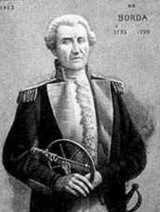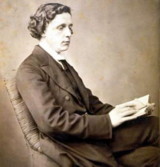From Impossibility to Possibilities
Arrow’s Impossibility Theorem presents a dire situation: no election procedure satisfies Arrow’s sets of axioms, except for a dictatorship. This does not mean that democracy is flawed and that a dictatorship is the only reasonable form of government. If Arrow’s axioms are too stringent and no election procedure satisfies the axioms, then either a smaller set of axioms or a different set of criteria may allow election procedures to be compared – with the objective of finding a “best” procedure. The definition of “best” is relative to what properties are desirable in the procedure. Below is a list of criteria that some have used to evaluate election procedures to arrive at their conclusion as to which procedure(s) is "best."
Condorcet Winner
 |
In 1770, Jean Charles de Borda proposed using
the Borda count to determine admission into the French Academy of Sciences. In 1785,
Marie-Jean-Antoine-Nicolas de Caritat Condorcet (the Marquis du Condorcet)
argued that the Borda count was flawed because it does not necessarily
elect a candidate that defeats every other candidate in a head-to-head
election. Condorcet considered what would happen on elections between
all pairs of candidates and generalized majority rule in a different manner. Consider
the following example in which five voters rank the four candidates A, B, C,
and D. |
1 |
1 |
1 |
1 |
1 |
A |
B |
D |
A |
D |
C |
C |
A |
B |
A |
D |
D |
C |
D |
C |
B |
A |
B |
C |
B |
For the above preference data, in a head-to-head election between two candidates, one must receive more votes than the other because of the odd number of voters. For example, D defeats A, because three voters prefer D to A (those voters whose preferences are in columns 2, 3, and 4 above) while only two voters prefer A to D (those voters whose preferences are in columns 1 and 5 above). Similar calculations can be used to show that D defeats A, B, and C in pairwise contests. Condorcet argued that a candidate that defeats each other candidate in head-to-head elections under majority rule should be elected. Such a candidate is called the “Condorcet winner.” The head-to-head election data for the above example appears below.
D |
A |
— |
D |
B |
— |
D |
C |
3 |
2 |
— |
3 |
2 |
— |
3 |
2 |
— |
— |
— |
— |
— |
— |
— |
— |
A |
B |
— |
A |
C |
— |
B |
C |
4 |
1 |
— |
1 |
4 |
— |
2 |
3 |
The Borda Count May Not Elect the Condorcet Winner
Condorcet considered the Borda count flawed because it would not necessarily elect the Condorcet winner. The above five-voter example (in which voters’ preferences are for candidates A, B, C, and D) provides proof. The Borda count voting vector is written to the left of the preferences.
Borda |
— |
— |
— |
— |
— |
count |
1 |
1 |
1 |
1 |
1 |
3 |
A |
B |
D |
A |
D |
2 |
C |
C |
A |
B |
A |
1 |
D |
D |
C |
D |
C |
0 |
B |
A |
B |
C |
B |
Candidates A, B, C, and D receive 10, 5, 6, and 9 points, respectively. Hence,
A wins the election under the Borda count, as opposed to the Condorcet winner
D.
A’s points: 2*3 + 3*2 + 0*1 + 1*0 = 10 B’s
points: 1*3 + 1*2 + 0*1 + 3*0 = 5
C’s points: 0*3 + 2*2 + 2*1 + 1*0 = 6 D’s points: 2*3
+ 0*2 + 3*1 + 0*0 = 9
 |
Unfortunately, a Condorcet winner does not
always exist. (See
the boxed entry.) An election procedure that always elects the Condorcet
winner when one exists satisfies the “Condorcet criterion.” Many
mathematicians and voting theorists have proposed procedures that satisfy
the Condorcet criterion, including English mathematician Charles Dodgson. Even
though he was a mathematical lecturer at Christ Church, Cambridge University,
Dodgson is better known under his pen-name, Lewis Carroll, the author Alice’s
Adventures in Wonderland. |
Condorcet Cycle
The following example is the simplest example of a “Condorcet cycle,” in which no Condorcet winner exists. Assume that there are 3 voters that rank order candidates A, B, and C as below.
In a head-to-head election between A and B, A wins the election under majority rule by winning 2 of the 3 possible votes. In a head-to-head election between B and C, B wins by a margin of 2 to 1. Finally, A defeats C by the same 2-to-1 result.
A |
B |
— |
B |
C |
— |
C |
A |
2 |
1 |
— |
2 |
1 |
— |
2 |
1 |
This is known as a Condorcet cycle because in pairwise contests, A defeats B, which defeats C, which defeats A. |
|
Ease of Use and Easily Understood
An election procedure should be easily used so that voters can accurately
reflect their preferences for the candidates. Further, an election
procedure should be easily understood by the electorate so that there is
confidence in election outcomes. If a “best” election procedure
is too complicated to use or to understand, then the electorate may not trust
election outcomes, regardless of whether or not mathematics has baptized
the procedure as “best.”
For example, as the number of candidates increases, it may be impractical
to assume that voters can rank order all candidates (see “How
to Vote”),
as required with most election procedures. Approval voting has been
supported in part by Brams and Fishburn because it is easily understood and
requires voters to only decide to “approve” or to “disapprove” candidates. Others
have argued that there is too much flexibility in approval voting. Even
though two voters may rank order candidates the same way, they may divide
them into the two categories of “approve” and “disapprove” differently,
so that rank-order preferences are not enough to determine an election outcome.
Least Manipulable
The objective on an election procedure is to determine an outcome that represents
the will of the people. Because voters can misrepresent their true rankings
of the candidates and affect the outcome of an election in a way to improve
the result (such as voting for a second-most preferred candidate when one’s
top choice is far behind in the polls), a “best” election procedure
would prevent voters from misrepresenting their preferences to achieve a better
outcome. In voting theory, this property is called “strategyproof.” That
is, an election procedure is strategyproof if it is never in a voter’s
best interest to vote strategically and misrepresents its preferences. Is
there such a strategyproof procedure?
Simultaneous Discovery!
Allan Gibbard and Mark Satterthwaite independently proved what has become known as the Gibbard-Satterthwaite Theorem, which states that, other than a dictatorship, there is no strategyproof procedure for elections among three or more candidates. Gibbard published an article with the result in 1973. Satterthwaite’s contribution was part of his doctoral thesis at the University of Wisconsin. Although done independently and with no knowledge of one another’s work, because Gibbard’s work had been accepted for publication, Satterthwaite was not able to publish the result as it appears in his thesis. He published a version in 1975, in which he tied the result to Arrow’s Theorem.

Mark Satterthwaite
See "References and Links" for bibliographic references.
|
|
Unfortunately, in an Arrow-like result, Allan Gibbard and Mark Satterthwaite
showed that the only strategyproof election procedure for three or more candidates
is a dictatorship! Their work was done independently of one another in the
1970s.
Because all non-dictatorship election procedures are susceptible to
strategic voting, a next question is to determine if there is a procedure
that minimizes the likelihood of strategic voting being useful. Donald G. Saari, University of California, Irvine, asked and answered this question. He
proved that the Borda count minimizes the likelihood that misrepresentation
of preferences or strategic voting can be used for benefit.
A Definitive Answer?
For an election with three or more candidates, there is no definitive answer to what is the best procedure. The answer is relative. A best procedure may depend on context (e.g., how many candidates) and which properties are deemed important for the election. One thing for sure: don’t vote on which election procedure to use!



